Some of the links in this post may be affiliate links.
Can you grow Spanish Moss indoors? You sure can! It’s not just the cool plant that you see hanging off oak trees and bald cypress trees in the southern United States. You can actually enjoy this unusual plant indoors and it can be surprisingly easy to care for.
Keep reading to learn more about how to grow this plant indoors.
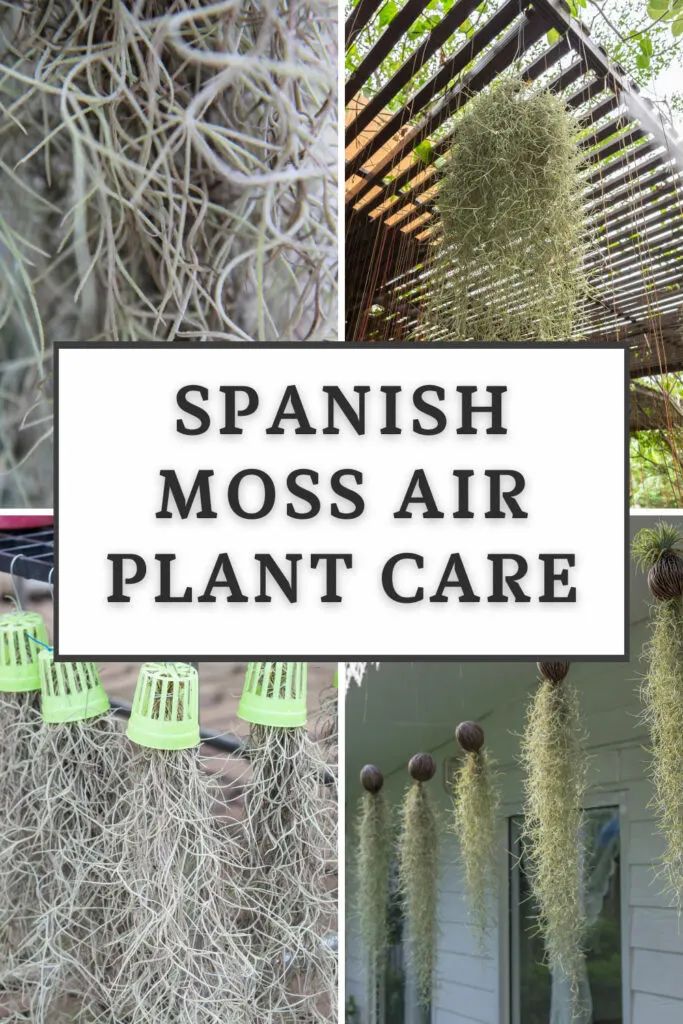
Table of Contents
ABOUT SPANISH MOSS
Before I get into Spanish Moss care, let me discuss a few facts about this unique plant. It is very helpful to learn a few things about this plant in order to understand its care.
WHAT IS SPANISH MOSS?
But first, what is Spanish Moss? The scientific name for this plant is Tillandsia usneoides. You may be familiar with many other Tillandsia varieties (commonly known as air plants).
Spanish moss is indeed an air plant. Other common names for Tillandsia usneoides other than Spanish Moss include Spanish Beard and Old Man’s Beard.
French explorers often called it Spanish Beard due to the resemblance of the beards of Spanish Conquistadors, while the Spanish often called it French Hair.
Spanish Moss is an epiphytic plant, which means that it grows on other plants, typically trees. Although one of the common names for this plant is Spanish Moss, it is not a moss at all, and is part of the bromeliad family.

WHERE DOES SPANISH MOSS COME FROM?
You will often see this delicate silvery-grey air plant hanging on tree branches of their host tree in the southern parts of North America, but they are also native to quite a few countries in Central America and South America.
CAN YOU GROW SPANISH MOSS ON ANY TREE?
I’ll get to indoor care next, but outdoors, Spanish moss tends to prefer southern live oaks and bald cypress. It can easily be grown though on other trees though. It is an epiphyte and NOT a parasite so it will not harm whatever tree that it grows on.
Unlike other Tillandsia (air plants) that grow roots to attach themselves onto trees, Spanish Moss has no roots. They have tiny little scales on the leaves which they use to cling onto their host tree.
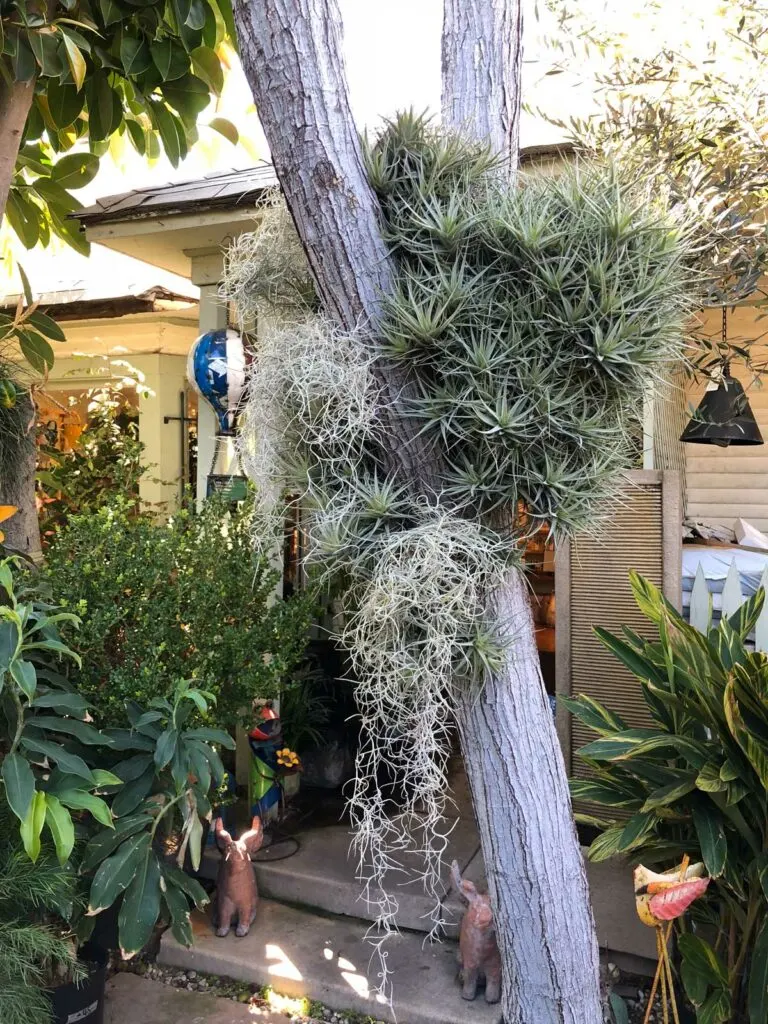
SPANISH MOSS AIR PLANT CARE GUIDE
1. DISPLAYING
The beauty of growing Spanish Moss is that there is no soil and all you have to do is hang your plants however you’d like. In many ways, they’re easier than displaying other types of air plants because Spanish Moss is very flexible and you can wrap the hair-like strands around anything.
As long as your light is appropriate (see the next section), you can drape them over a potted plant, hang them from a ceiling hook, or even drape them over a plant stand. Your imagination is the limit!
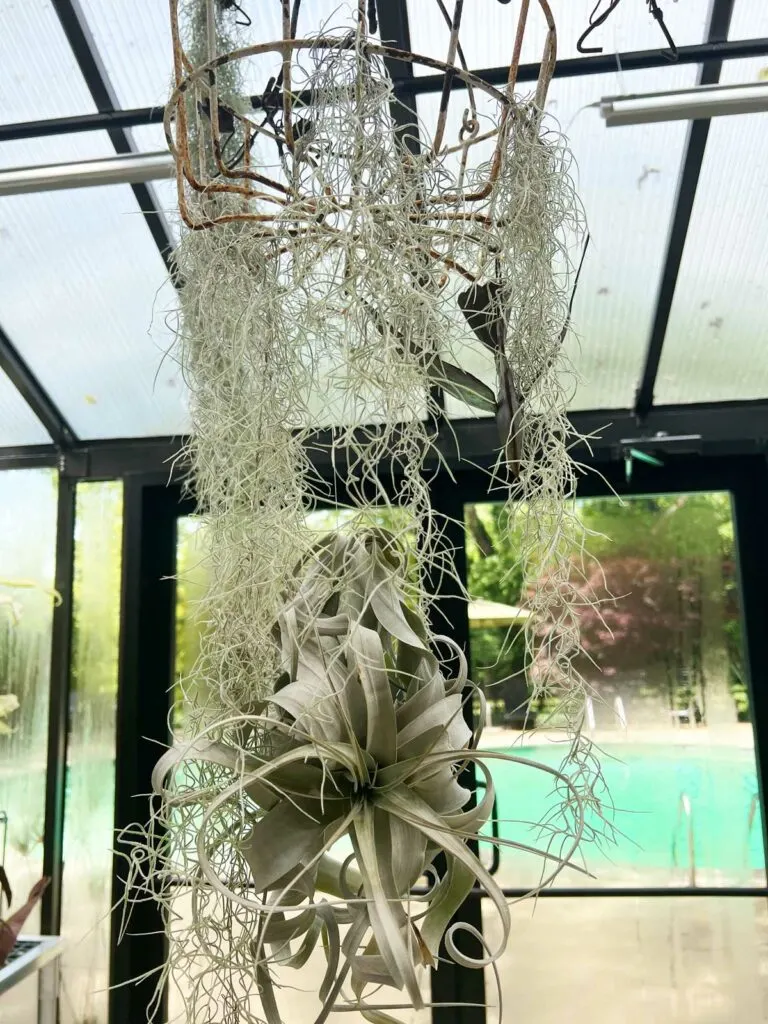
You can even hang them in your shower if you have enough light, or even make a living curtain. They make a natural companion plant to orchids and bromeliads, which are fellow epiphytes.
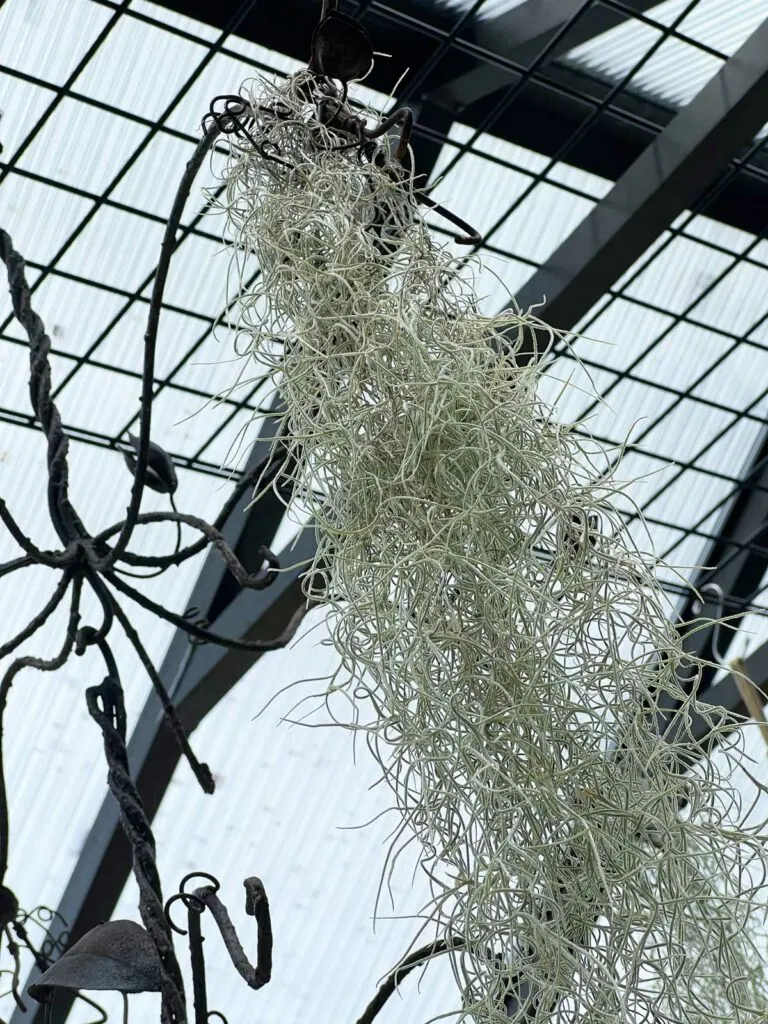
Spanish moss is also sold dried, so this is not the kind that you want. You’ll want to purchase living Spanish moss. I like to purchase Tillandsia plants from Air Plant City.
They have reasonable prices and a nice selection, and the plants are always nice and healthy!
2. LIGHT
If you think about how this plant grows in nature, it hangs off branches of large trees, so it gets filtered light or dappled sun.
Indoors however, we have to remember that the light intensity is a lot less than it is outdoors (I talk about this in detail in my book, Houseplant Warrior: 7 Keys to Unlocking the Mysteries of Houseplant Care (link to Amazon).
Therefore, it is OK (and beneficial!) to give your Spanish Moss some direct sun indoors. Right in front of an Eastern facing window (with direct sunlight in the morning) is ideal.
Western-facing windows are also great.
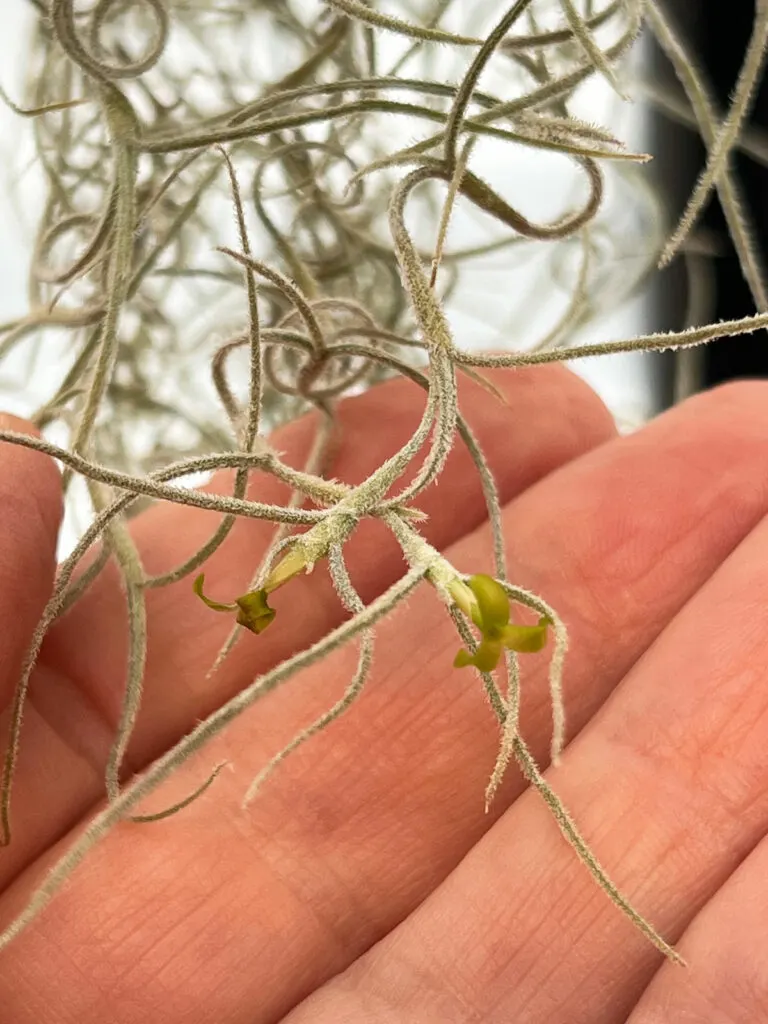
You’ll want to avoid windows that have sun all day because this will quickly dry them out and it will be hard to keep up with watering.
If you only have windows that have no direct sun at all and only “bright indirect light”, be sure to place your Spanish Moss immediately in front of the window. Light intensity drops very rapidly with even short distances the further you move away from a window.
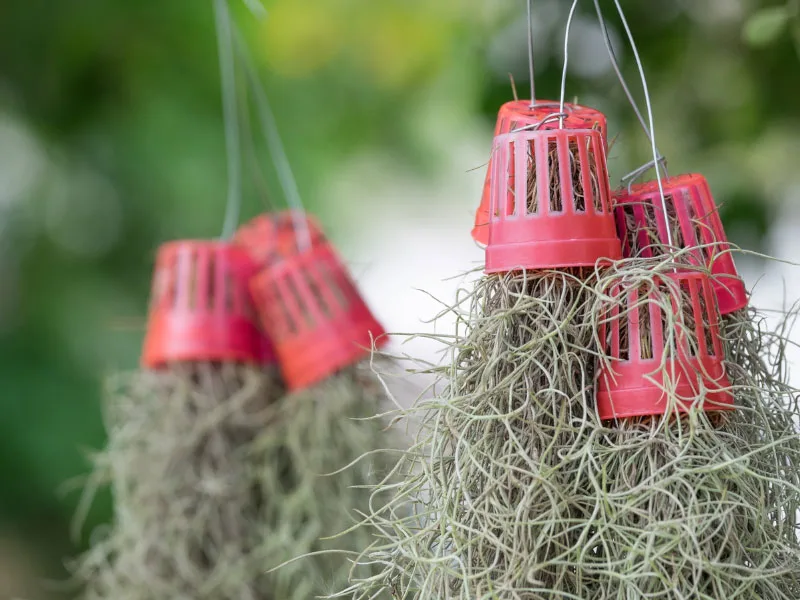
3. WATERING
Watering your Spanish Moss is simple. Natural water sources, like rainwater, are best, but tap water will also do. Try and use room temperature water and not cold water.
Regular watering indoors (particularly if you have dry air) is important, as is providing good air circulation.
There are a couple of ways to water your Spanish Moss. Depending on how you have your plants displayed, you can either soak your plants in a bucket of water or in a sink for about 30 minutes, or mist them. You can also use a combination of both.
I grow my Spanish moss in my greenhouse and I usually mist it every single day, but I really try and soak it until it’s dripping. I use a pressure sprayer with the wand set on the continuous spraying setting) so that I don’t have to hold the trigger on the nozzle down and fatigue my hand.
Indoors, the easiest way to water your Spanish Moss is to give your plants a good soaking about once a week or so, and then mist it 2-3 times per week in between the soaking. If it’s not practical to soak in a sink or bucket of water, you can mist everyday or at least every other day.
You will know if you’re not providing enough water because the strands will dry up and turn brown.
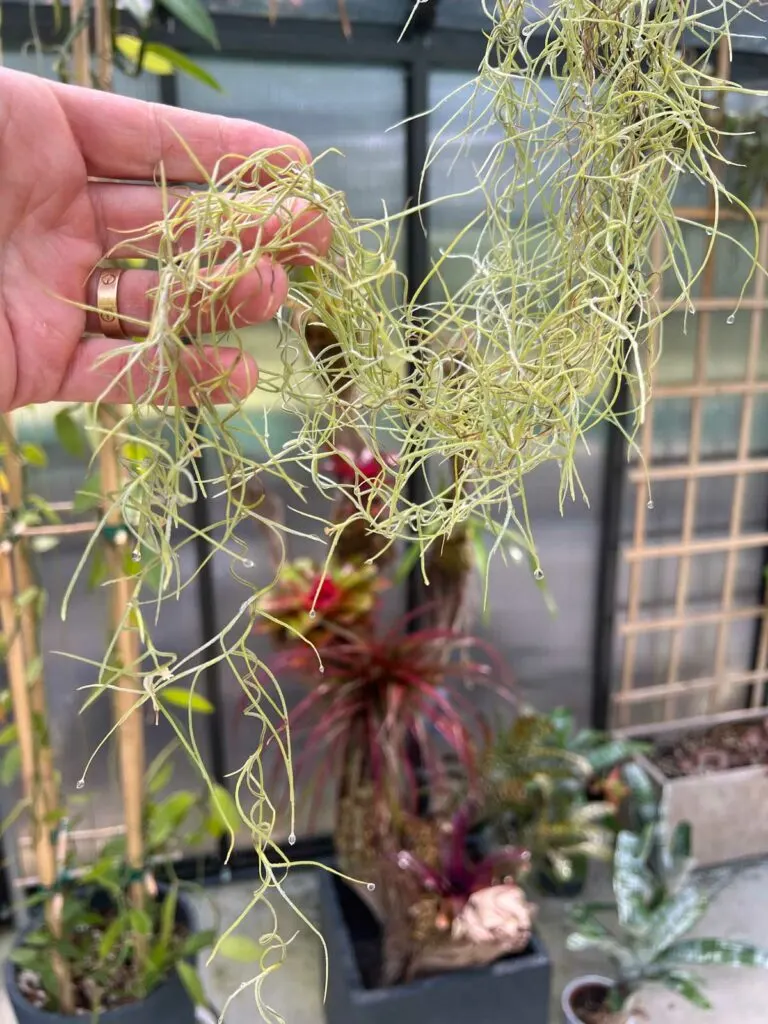
When you mist, try and soak your plant until water starts dripping off. You may want to bring your plants to the shower or bathtub so you’re not making a mess.
If you have a dense clump of moss, it’s even more important to be thorough in watering. If you find that it’s too hard to get the strands wet on the inside of your clump, you may want to tease some of the plants out to thin out the clump.
Then you can use the plants that you’ve thinned out to place somewhere else.
Thinning out the plants will make it easier for light to get to the center, as well as make watering easier. If you have a clump that is too dense, you may see the plants on the inside start to die.
You may want to consider placing your Spanish Moss plants outdoors during the warm summer months. The warmth, rainwater, and humid conditions will benefit your plants.
Place them under a tree, or hanging on tree branches, where they’ll be in the shade or dappled sun.
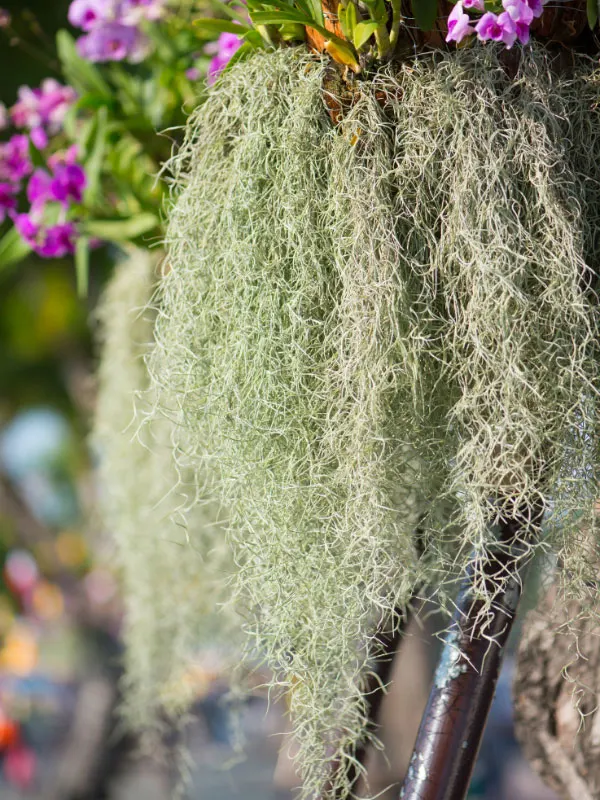
As far as fertilizing goes, maybe once a month or so during the growing season, I’ll fertilize it with Dyna-Gro Grow.
I use this for all my tropical plants, and for Spanish Moss, I simply mix in 1/4 to 1/2 teaspoon per gallon and spray it down with this solution.
This is an amazing fertilizer and it contains all the macro and micro nutrients that plants need to be healthy. I’ve been using this fertilizer for years with wonderful results!
SPANISH MOSS VARIETIES, CULTIVARS & HYBRIDS
Tillandsia ‘Maurice’s Robusta’
This cultivar is a thicker form of the species T. usneoides that was collected in the wild by Marice Kellett.
Tillandsia ‘Munro’s Filiformis’
This is a natural variety with green leaves and is native to Paraguay.
Tillandsia ‘Odin’s Genuina’
This is another natural variety with brown flowers and is native to Guatemala and Mexico.
Tillandsia ‘Spanish Gold’
This is a form of T. usneoides with yellow flowers.
Tillandsia ‘Tight and Curly’
This is a form of T. usneodies that is sold by California Gardens.
Tillandsia ‘Nezley’ (Tillandsia usneoides x mallemontii)
Tillandsia ‘Kimberly’ (Tillandsia usneoides x recurvata)
Tillandsia “Old Man’s Gold’ (Tillandsia crocata x usneoides)
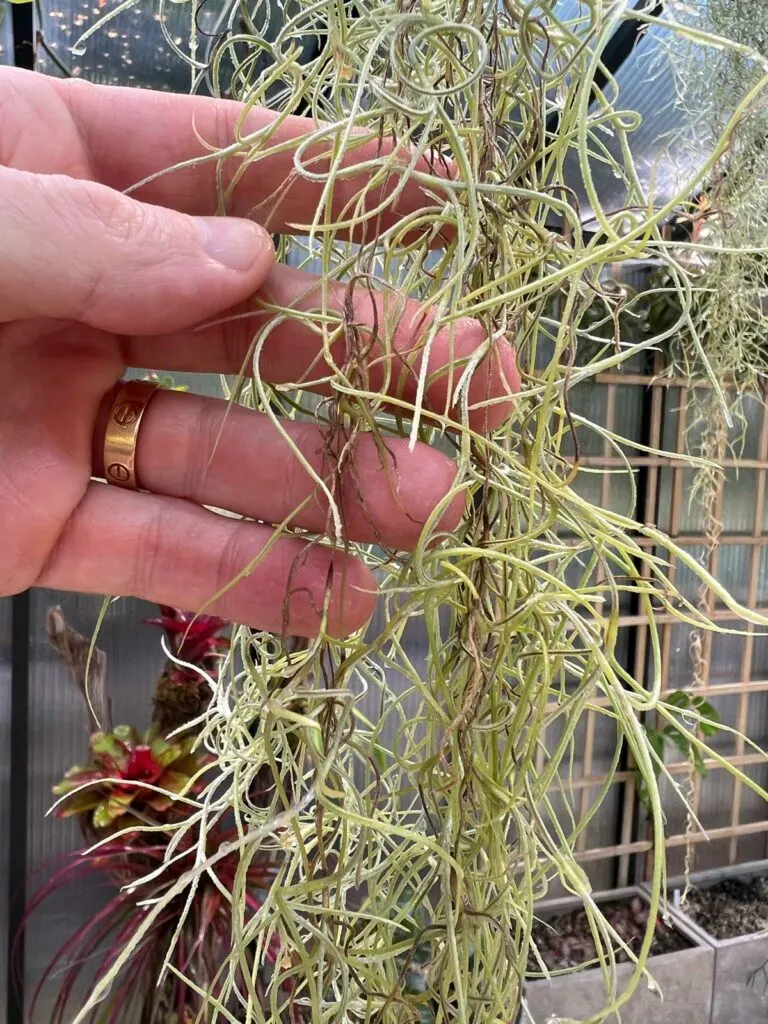
I hope you’ve enjoyed this post on Spanish Moss air plant care. Have you tried growing Spanish moss? Comment below. I’d love to hear!

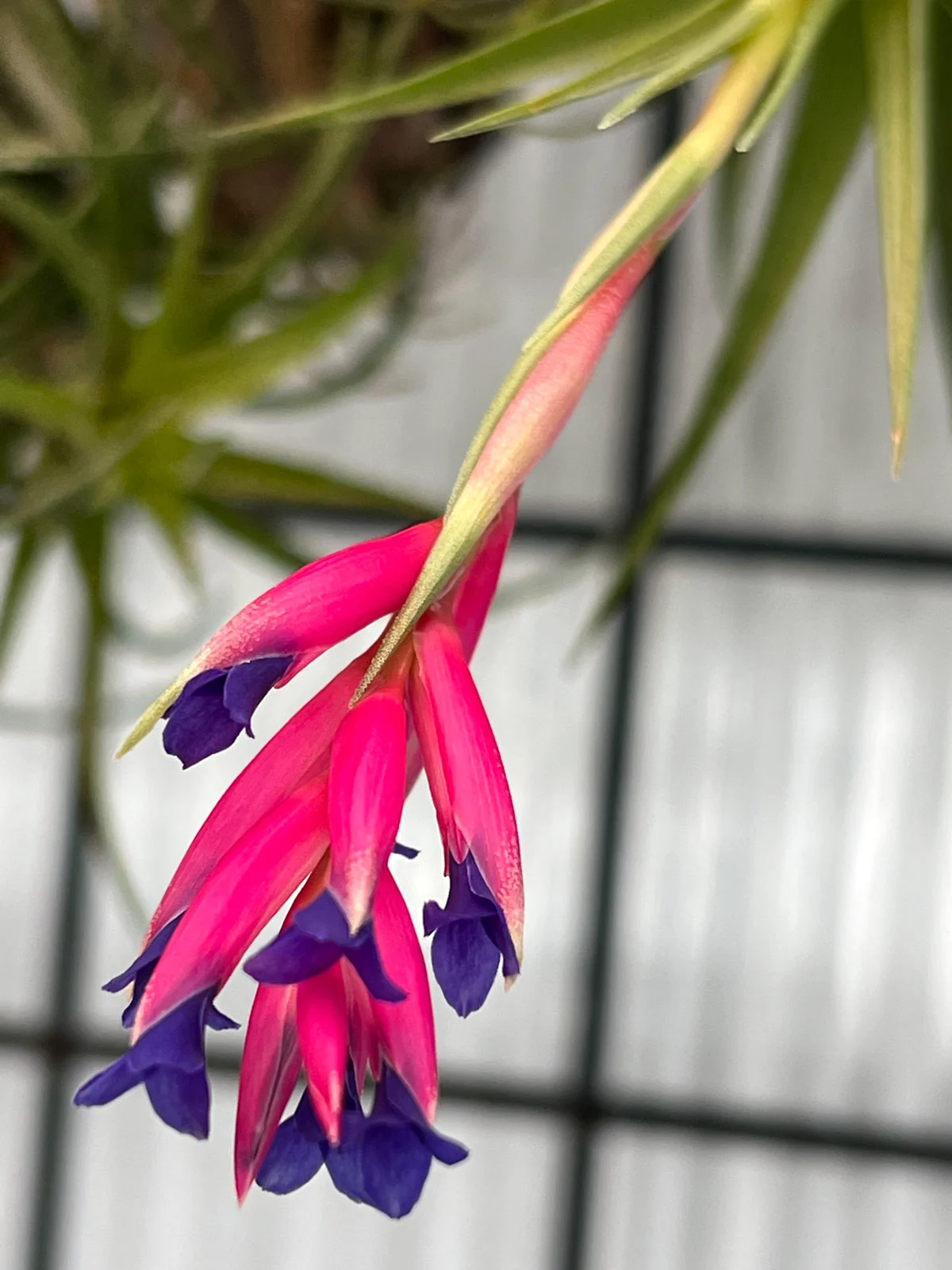
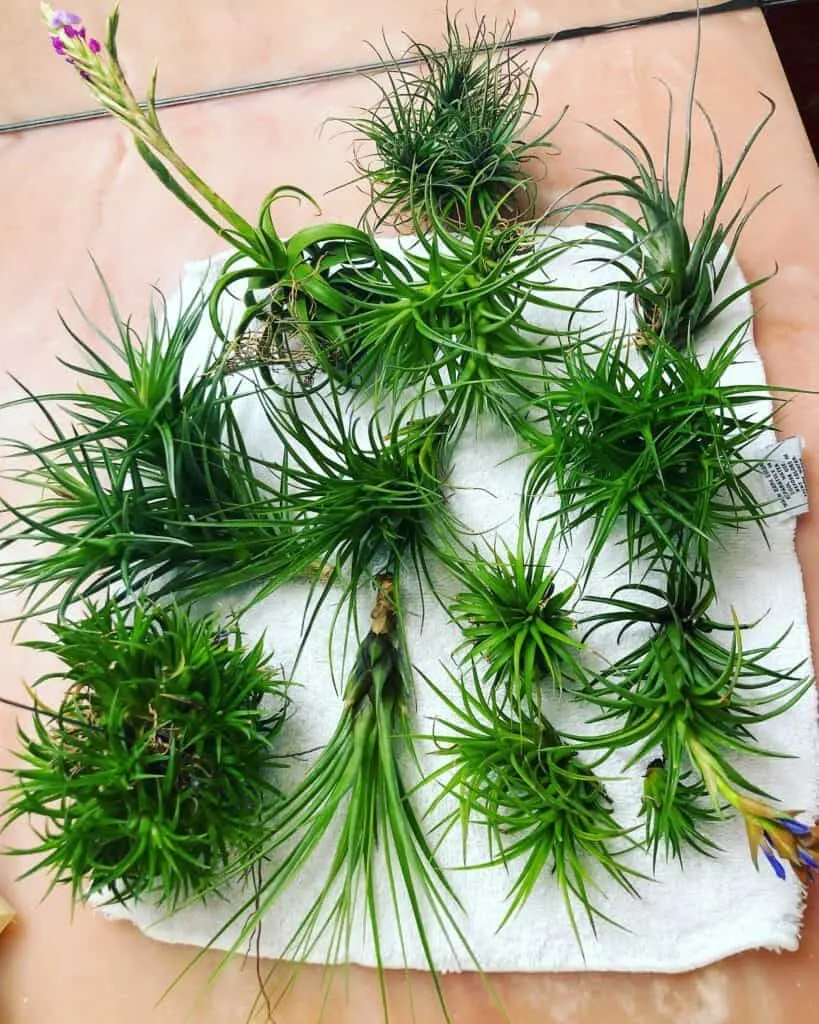
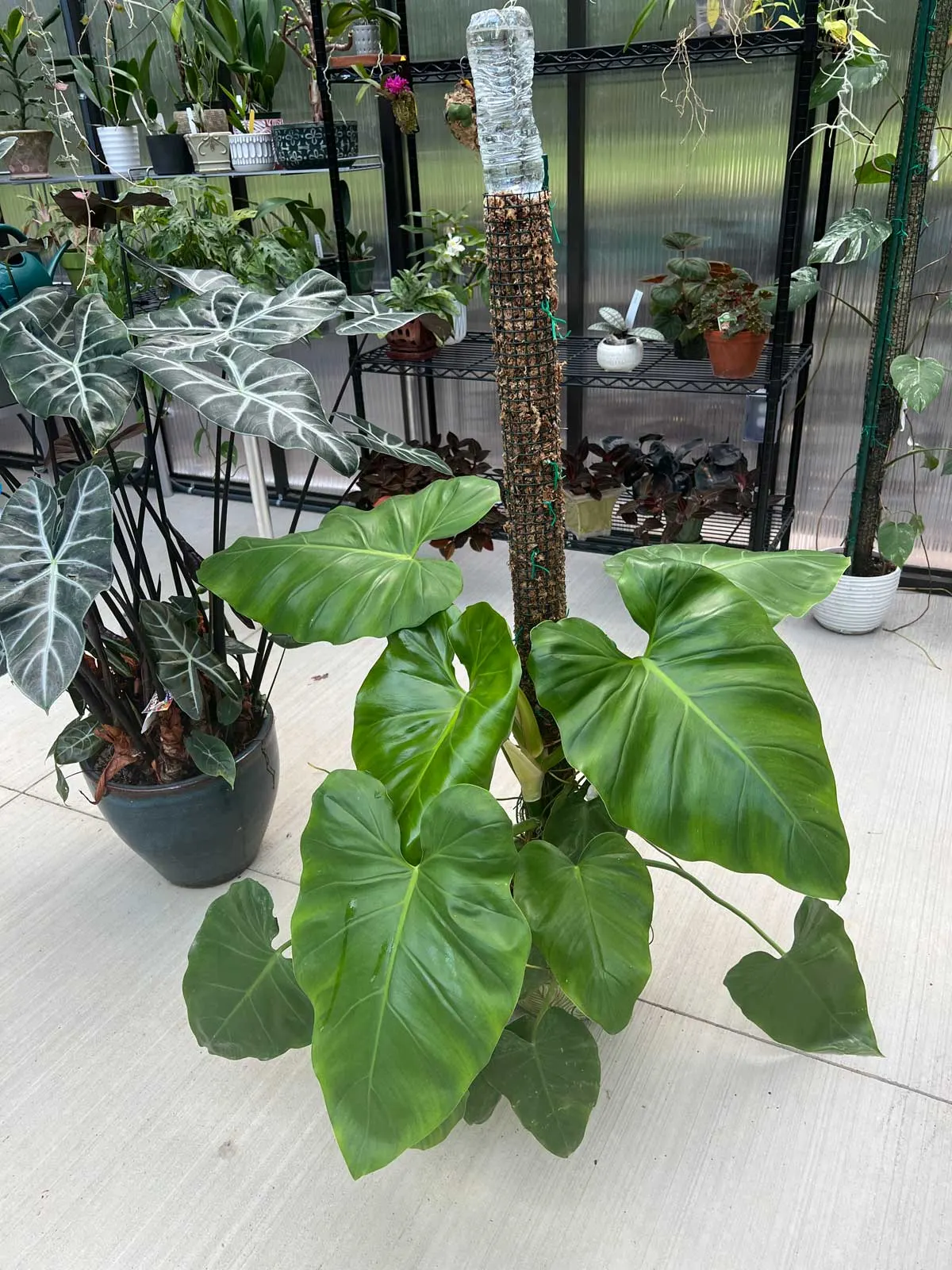
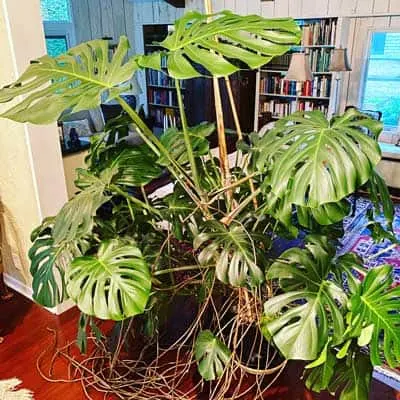
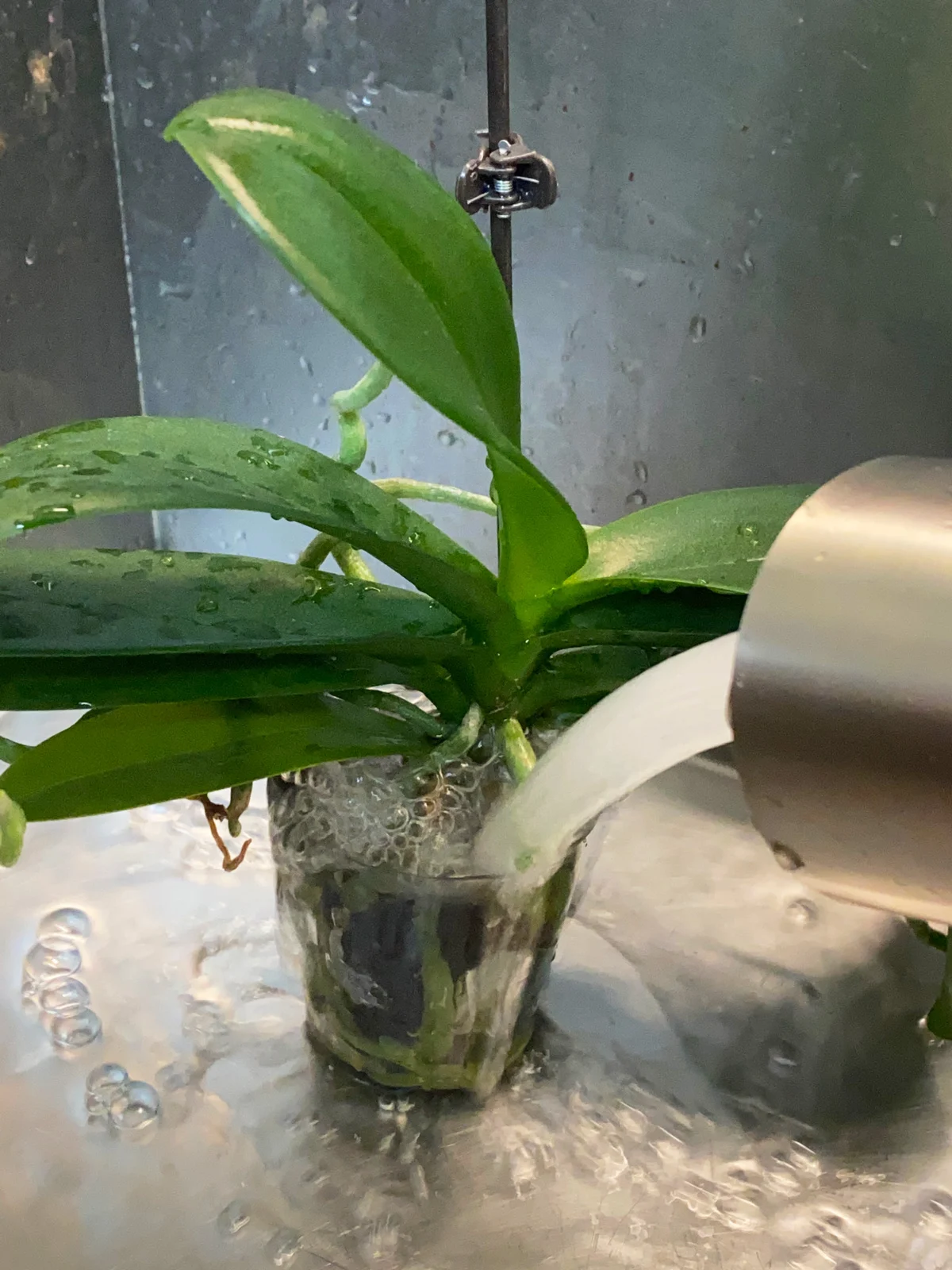
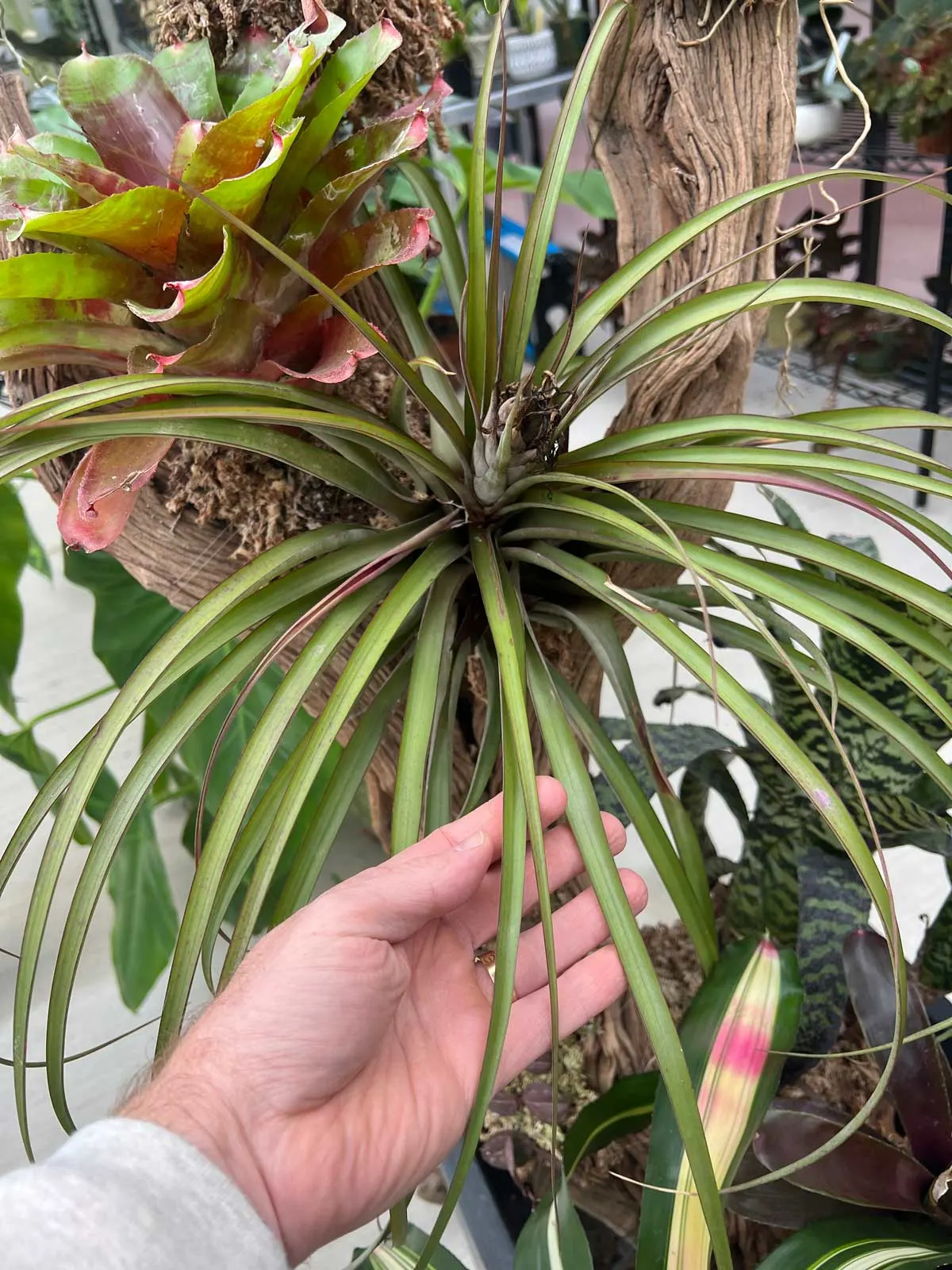
Steve
Saturday 9th of December 2023
Great advice. I have a bathroom with many usneoides, and a tree in my garden covered in Usnea. Which is circular and nice 🤔.
Raffaele
Monday 11th of December 2023
Hi Steve! Glad you enjoyed the article, and your tree sounds lovely!
Amanda
Thursday 3rd of August 2023
I live in south Alabama where Spanish moss is abundant in certain places. I recently acquired a piece of driftwood while on a walk near a bay, and my husband drilled several holes into it for me to put air plants in (after a thorough cleaning to rid it of bugs, of course). They seem really happy in their driftwood and the holes are large enough that they don't compress the plants at all, rather the plants fit inside them to hold them upright. I wanted to drape Spanish moss around the empty spaces on the driftwood to fill in the gaps between the other plants. The driftwood sits on a shelf in front of an east-facing window. Do you think I could bring home some moss from one of my nature walks and it would adjust to living indoors? Thanks for a great post!
Steve
Saturday 9th of December 2023
@Amanda, I don't like invertebrates being referred to as "bugs or creepy crawlies". I believe language is important in the increasing demise of young peoples' enjoyment of and engagement with ecosystems. (Believe it or not, I do have a sense of humour 😄).